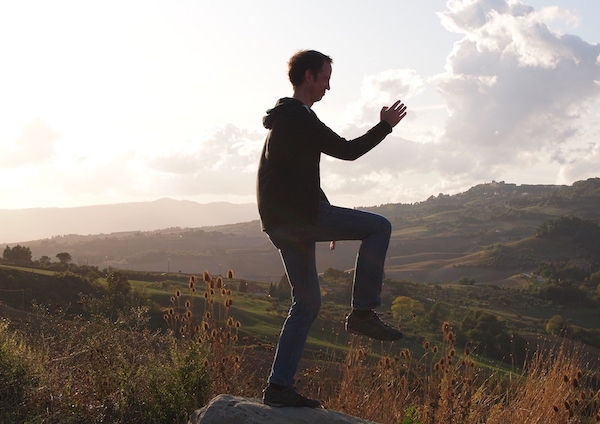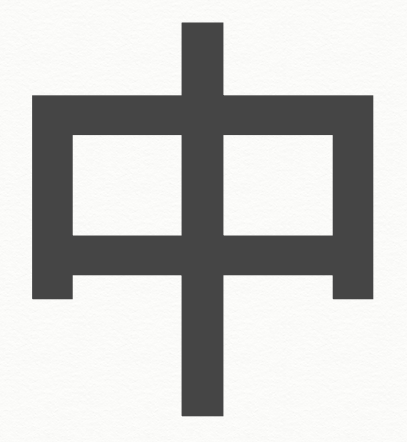In Tai Chi, our body begins at the soles of our feet and ends at the top of our head, as far as the vertical line is concerned. Our body should be upright, our mind should be calm or untroubled. – How to achieve that? Time to work on our centre line!
Awareness of the Baihui as highest point of our body
The Baihui is located at the highest point of our head. It is also the highest point of our body’s central line. To feel it during the form, we just put a bag of rice or some other convenient item on our head. The weight does not matter, it should only serve as a reminder. The task is simple: do not drop it while doing the form. (If your form features postures where the application is to pull somebody to the ground, you are allowed to cheat in-between.)
After doing the form 3 to 5 times with your „reminder“, do it once again without it and reflect on the experience.
I am now centred in the middle! – Why does it feel so strange? (Or why doesn’t it?)

A calming and centred experience is the usual result when practising this Tai Chi Aspect. This also squares with Chinese medicine: The Baihui as the meeting point of Yang meridians is said to calm the mind.
However, if you are used to application or to the experience of the full range of movement in push hands, practising this Tai Chi Aspect will somehow feel artificial. The movements become less grounded and fluent, the shapes of the postures tend to become sharper and emptier at the same time.
In a way, the awareness needed to balance something at the top of your head automatically takes some compression out of your fingers. At the same time, we may clearly feel that the over-emphasising of the vertical line seems to compromise the horizontal aspect, i.e. our expansion sideways and against the floor. As a consequence, our movement as a whole seems to become less three-dimensional.
On the other hand, stressing the vertical aspect makes the form more compact and static, boosting the stability of the movement. But it may also lead to loosing our lines of action, as can be seen in gymnastic or wushu forms that work with the central line to focus on artistic expression and appearance.
How to solve this dilemma?
Finding your centre (中): A two-step process

A perfect opportunity to learn something from Chinese calligraphy. The Chinese character for centre is 中 (zhong): A box with a striking central line. How do you write it? – The correct order is to first draw the box and then put the center line in its middle. The calligrapher does not draw the centre line first and will then proceed to draw the box around it.
What does that mean for the development of our Tai Chi form?
- Drawing the box – Developing your lines of action
First things first: Mastering stepping, weight shifting and single-weighted action (i.e. action on one leg) comes first. Develop your left and right axis – these elements define your „box“, your frame of movement. If you have these Tai Chi Aspects at the tips of your fingers (pun intended – see Tai Chi Aspect Digging), the centre line may be worth a try.
One might add that before this stage, any work with the centre line may be an exercise for the mind (awareness), but not the brain (nervous system). If you are a beginner and really want to work intensively with your centre line, it may best be experienced in seated / static meditation or other activities, in which the spine is not required to rotate in space.
- Adding the centre line – Experiencing harmony in changing the sides
When you proceed to add the centre line, do it carefully. Do not get carried away with the elevated feeling. Take your heart and body with you. And: Do not paint the centre line so thick that the box is gone. It is – in many ways – a fine line.
Have fun experimenting!
Profile: Tai Chi Aspect # – The Baihui
- Difficulty: advanced
- Goal: bringing calmness into movement
- Method: over-emphasising, self-reflection, working with concepts
- Element: earth (mountain)
- Related Tai Chi Aspects: Leverage
Video Bai Hui – Tai Chi Aspects
- Always move “just enough” (passive stepping)

- Tai Chi stepping 9/10 – Always leave the line of attack

- Tai Chi stepping 8/10 – Match your steps

- Tai Chi stepping 7/10

- Tai Chi stepping 6/10

- Tai Chi stepping 5/10 – Watch your back

- Tai Chi stepping Rule 4 – Keep connected to the ground

- Tai Chi stepping rule 3

- Tai Chi stepping rule 2

- Tai Chi stepping rules

- PLAY TAI CHI – Tai Chi Aspects

- Fast Forward – Tai Chi Aspects


















